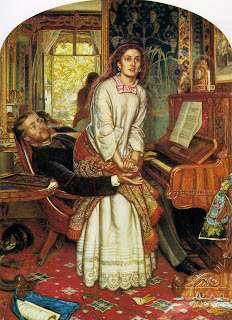This is an 1826 photographic experiment that is the first surviving photo of an outdoor scene. The point was that many artists came to believe, as photography became more common, that realism as a style was dead. Here's a photograph, from 1839 or 1840, that is one of the oldest surviving portraits.
This is Dorothy Draper, an American girl photographed by her brother. Early photos were not snapshots like the thousands of pictures taken on cell phones everyday. Because of the long exposure times each one was posed and carefully thought out. This gives this photo and many other early photos the quality of a portrait painting. In fact the extraordinary sophistication and artistic qualities of this portrait are probably what accounts for its survival. I think one of the finest American portraits photographic or otherwise.
Things didn't change immediately however. While Monet, Renoir, and Van Gogh pushed painting towards abstraction, realism continued to flourish. Here's two example from England.
This is William Holman Hunt's famous "The Awakening Conscience" from 1853. The second is Frederic Leighton's "Duty."
Which finally brings us to the topic of the day the British woman Julia Margaret (Pattle) Cameron. Her she is in a photo taken by her brother-in-law when she was 45.
Three years later her children gave her a camera of her own, and she began an astonishing eleven year career (1864-1875). She had certain advantages being of the right class and summering on the Isle of Wight near a number of Victorian era celebrities like Tennyson. While she did not invent the technique of soft focus for portraits, she developed the technique to its highest point through the use of long exposures-the subject moved just slightly over time creating a blur, or through defocusing the lense. This allowed her to create some striking portraits like this of Julia Jackson, the future mother of Virginia Woolf:
Or this one of the historian Thomas Carlyle, looking the way all historians should:
Neither picture follows the photographers "rule of thirds"-look at the lack of nose room, but I think that only adds to the portraits' mystery.
Cameron wasn't content to just take portrait shots, however. She wanted to shoot what were known as "fancy portraits." These were illustrations of historic events, or literary themes using people other than the people actually involved. The two paintings above are more or less in that category. The interesting thing is that I don't think Cameron's shots work. Take a look. First a domestic scene called "Pray God Bring Father Safely Home."
The Victorian sentimentality of the title doesn't help very much, but look at Cameron's props for a Victorian room and compare that to the much more salacious scene from Hunt where the mistress finally awakens to her sinful status. Cameron has clutter, while most objects in the painting are symbolic of the woman's "kept" status. Also, the requirements of early photography make the scene stiff and artificial while Hunt's painting seems vibrant and alive.
Here's another example. Compare Cameron's "The Parting of Lancelot and Guinevere" with Leighton's "Duty."
Certainly better than the previous photo. One could imagine a LaFarge or a Tiffany using this as a model for a stained glass window. The pose is a romantic although rather chaste one of sadness. With the armor and the page (or son), Leighton's painting has more going on than the Cameron photo, but if you focus on the couple you once again see that painting can provide a much livelier scene-the wife imploring and the man torn by his different duties. Cameron's camera couldn't capture the full range of emotions that remained the field of painters into the 20th century.
Julia Cameron had been born in India and educated in France before returning to India and getting married. After many decades back home in England, the Cameron's moved to Sri Lanka where Julia Cameron died in 1879 at the age of 64. Despite being the most gifted and prolific amateur in Britain during her 11 year career. Her soft focus portraits drew criticism and art critics tended to dismiss her more posed works. She was largely forgotten until the mid-20th century when photographers and historians alike recognized the beauty and advanced technical features of her work.









No comments:
Post a Comment